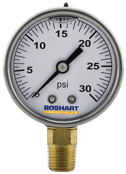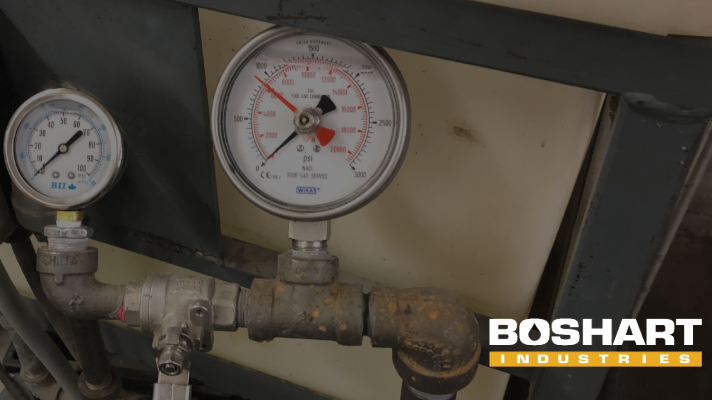BoshartU was born from a collaboration with multiple departments at Boshart like Quality Assurance, Research and development and Sales and Marketing. We write blogs to educate you on plumbing, water well, Waterworks, HVAC, irrigation, industrial, pool and spa and sump and sewage products.
We have created a series where we take our blogs, starting from the very beginning, and put them into videos.
To view all of our blogs that we have turned into videos, head to BoshartU & don’t forget to subscribe!
This video is based off of a blog we wrote called “When to Select a Liquid vs Dry Pressure Gauge". The original blog was published on October 16, 2019. To view the original blog, check it out here. Or, read the transcript below.
Transcript
Introduction
Hi, I’m Braedlyn McEwen and today we are going to talk about Pressure Gauges.
When it comes to choosing a pressure gauge, the decision might seem simple. Liquid filled or dry. But before jumping to a decision, there are some factors to determine which gauge is the right fit for you and your application.
Being informed about the assets and drawbacks of liquid and dry gauges could save you time and money. In this video, we will go over when and why you should choose a liquid gauge over a dry gauge. This will help you make the right choice the next time you require a pressure gauge.
Why Select a Liquid Filled Gauge?
Liquid filled gauges are used for measuring pressure points of high stress like fast and frequent loads, pressure peaks and mechanical vibrations. Liquid filled gauges are typically filled with either glycerine only or a combination of glycerine and water. Specific glycerine gauges are needed depending on the different conditions you require the gauge for.
fast and frequent loads, pressure peaks and mechanical vibrations. Liquid filled gauges are typically filled with either glycerine only or a combination of glycerine and water. Specific glycerine gauges are needed depending on the different conditions you require the gauge for.
Applications
Standard liquid filled gauges are filled with 100% (99.7% min.) glycerine which starts to become sticky at +17 degrees C, as the temperature decreases the more slimy the glycerine becomes causing the pointer to move slowly to the correct position. At -5 degrees C the gauge would stop operating completely. Locations with an even temperature that doesn't fluctuate often, would be the perfect home for a standard gauge.
Liquid filled gauges that have 2 parts glycerine with 1 part water can be used in temperatures as low as -46 degrees C. These types of gauges are ideal for locations that have extremely cold circumstances. For example, regions that have harsher winter temperatures may consider this type of gauge.
Most liquid filled gauges are completely airtight which allows them to perform in corrosive environments and are resistant to moisture intrusion and icing.
Environmental Benefit
Glycerine filled gauges are environmentally friendly by being non hazardous to water, they are non toxic and the glycerine is completely biodegradable.
Why Select a Dry Gauge?
In certain applications, a liquid filled gauge may not be the ideal gauge as the features may be excessive. Dry gauges are mainly used for industrial machines including air compressors. Ideal for environments where mechanical vibrations is not a concern and where there is little to no moisture. Low enough temperatures can cause moisture to convert to ice and that can cause the gauge to fail completely.
features may be excessive. Dry gauges are mainly used for industrial machines including air compressors. Ideal for environments where mechanical vibrations is not a concern and where there is little to no moisture. Low enough temperatures can cause moisture to convert to ice and that can cause the gauge to fail completely.
Although dry gauges are typically cheaper than liquid filled gauges, if used in incorrect applications it could cost you more money in the long run. Liquid filled gauges can absorb vibration and pressure spikes which will reduce the possibility of poor performance or failure. Low failure rate means less money spent purchasing replacements.
Both liquid and dry gauges are available in pressure ranges equal to each other but in some cases liquid gauges can be available in a higher range. Selecting the correct gauge off the hop is the key to saving you money.
In Summary:
In a nut shell, it is always good to be aware of the environment that the gauge is required for to ensure you select the correct one. It is also good to keep in mind the benefits and the disadvantages of each gauge. Every operation is different and could require particular gauges.
This video is based off of a blog we wrote called “When to Select a Liquid vs Dry Pressure Gauge". To view the original blog, check it out here.
Have further questions about this subject?
Head over to Boshart's Knowledge Base: technical product information, guidelines, and more.






SHARE